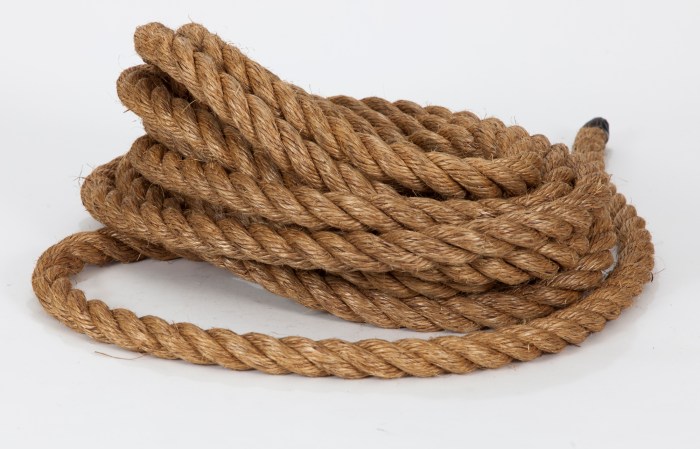
Get the Perfect Rope Twist: A Guide to Choosing, Creating, and Using the Right Rope
Get the perfect rope twist – it’s not just about aesthetics, it’s about functionality and safety. From the humble clothesline to high-performance climbing ropes, understanding rope twist is crucial for getting the most out of your rope and ensuring its longevity.
This guide delves into the world of rope twists, exploring the different types, their characteristics, and how to choose the right one for your needs.
We’ll cover the factors that influence rope twist, including fiber type, construction, and intended use. We’ll also explore the advantages and disadvantages of different twists, and how to create them yourself with step-by-step instructions and helpful tips. Whether you’re a seasoned rope enthusiast or a curious beginner, this guide will equip you with the knowledge to confidently choose and use ropes for any application.
Understanding Rope Twist

Understanding rope twist is essential for selecting the right rope for your specific needs. Rope twist refers to the way the strands of a rope are interlaced, which significantly impacts its strength, flexibility, and durability.
Types of Rope Twists
The way strands are interlaced in a rope determines its twist. There are several common types of rope twists, each with unique properties.
- Single Braid:This twist is made by braiding multiple strands together in a single direction. It’s known for its flexibility and resistance to twisting. Single braids are often used in applications where smooth handling is essential, such as climbing ropes and boat lines.
- Double Braid:In this twist, two single braids are interwoven, resulting in a more durable and abrasion-resistant rope. Double braids are commonly used for mooring lines, dock lines, and other applications where strength and durability are crucial.
- Kernmantle:This twist features a core (kern) made of a single braid surrounded by a sheath (mantle) made of a different type of fiber. This design provides excellent strength and abrasion resistance. Kernmantle ropes are often used in climbing, rescue operations, and other applications requiring high strength and durability.
- Spiral Braid:This twist is created by braiding multiple strands in a spiral pattern. Spiral braids are known for their high strength and resistance to twisting. They are commonly used in applications where strength and resistance to twisting are essential, such as rigging lines and tow ropes.
Factors Influencing Rope Twist, Get the perfect rope twist
Several factors influence the choice of rope twist for a specific application. These include:
- Fiber Type:The type of fiber used in the rope construction significantly affects its strength, durability, and flexibility. Natural fibers like hemp and cotton are known for their strength and durability, while synthetic fibers like nylon and polyester offer higher strength-to-weight ratios and resistance to water absorption.
- Construction:The way the strands are interwoven in a rope determines its twist and properties. A single braid rope is flexible and resistant to twisting, while a double braid rope is more durable and abrasion-resistant.
- Intended Use:The intended use of the rope determines the necessary strength, durability, and flexibility. For example, a climbing rope needs to be strong, flexible, and abrasion-resistant, while a mooring line needs to be durable and resistant to wear and tear.
Advantages and Disadvantages of Different Rope Twists
Each type of rope twist has its own advantages and disadvantages.
- Single Braid:
- Advantages:Flexible, easy to handle, resistant to twisting.
- Disadvantages:Less durable than double braids, prone to abrasion.
- Double Braid:
- Advantages:Durable, abrasion-resistant, strong.
- Disadvantages:Less flexible than single braids, can be stiff.
- Kernmantle:
- Advantages:High strength, abrasion-resistant, versatile.
- Disadvantages:Can be more expensive than other types of ropes.
- Spiral Braid:
- Advantages:High strength, resistant to twisting, durable.
- Disadvantages:Can be stiff, less flexible than single braids.
Choosing the Right Rope Twist: Get The Perfect Rope Twist

The twist of a rope is a crucial factor in determining its strength, flexibility, and overall performance. Understanding the different types of rope twists and their characteristics is essential for choosing the right rope for a specific application.
Rope Twist Types and Their Characteristics
The type of rope twist influences its properties, such as strength, flexibility, and durability. Here’s a breakdown of common rope twists and their characteristics:
- Single Braid:This twist involves a single strand of fibers that are braided together. Single braids are known for their flexibility and ease of handling, making them suitable for applications requiring smooth movement, such as climbing ropes or sailing lines. They are also relatively lightweight.
- Double Braid:This twist features two braids that are interwoven, resulting in a stronger and more durable rope. Double braids are often used for applications where strength and abrasion resistance are paramount, such as towing ropes or mooring lines.
- Plaited:Plaited ropes are created by interlacing multiple strands of fibers in a complex pattern. They are renowned for their exceptional strength and durability, making them ideal for heavy-duty applications like lifting and rigging.
- Twisted:Twisted ropes are formed by twisting multiple strands of fibers together. This type of twist is commonly found in ropes used for general-purpose applications, such as clotheslines or garden hoses. They are relatively inexpensive and readily available.
Factors to Consider When Choosing Rope Twist
Choosing the right rope twist depends on the specific application and the desired characteristics.
- Strength:The strength of a rope is determined by the type of fibers used and the construction of the twist. For applications requiring high strength, consider plaited or double-braid ropes.
- Flexibility:Flexibility is essential for ropes used in applications involving smooth movement, such as climbing or sailing. Single braids are known for their flexibility, while plaited ropes are less flexible.
- Durability:Durability refers to the ability of a rope to withstand wear and tear. Double braids and plaited ropes are highly durable due to their construction.
- Application:The specific application will determine the type of rope twist needed. For example, a climbing rope requires a flexible and strong single braid, while a towing rope requires a durable and strong double braid.
Examples of Rope Twist Applications
- Climbing:Climbing ropes are typically made from single braids, as they offer the necessary flexibility and strength.
- Sailing:Sailing lines often use single braids or double braids, depending on the size and purpose of the line.
- Towing:Towing ropes require high strength and durability, making double braids or plaited ropes suitable choices.
- Rigging:Rigging applications involve heavy lifting and require extremely strong and durable ropes. Plaited ropes are often preferred for this purpose.
Getting the perfect rope twist is all about finding the right balance of tension and direction. It’s a bit like finding the perfect fabric for a fabulous fabric scarf – you want something that drapes beautifully but holds its shape.
Once you’ve mastered the twist, you can create endless possibilities, from chic bracelets to sturdy macrame wall hangings.
Getting the perfect rope twist is all about finding the right balance of tension and control. It’s a bit like making those delicious pancakes I shared in my recent post on 20 neighbor christmas gift pancakes – you need the right amount of batter and heat to get the perfect golden brown color.
Once you’ve mastered the basic technique, you can start experimenting with different twists and variations to create unique and eye-catching designs.
Getting that perfect rope twist is all about finding the right balance, just like baking a delicious ooey gooey mud pie. Too much pressure and it snaps, too little and it’s loose. You need that sweet spot where the twist holds its shape, but still has a little give – just like the perfect mud pie crust!

